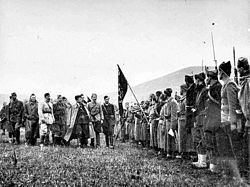Active 21 December 1941–1945 Disbanded 1945 Allegiance Yugoslav Partisans Size Brigade | Country Yugoslavia Notable
commanders Koča Popović Branch Infantry | |
 | ||
The 1st Proletarian Brigade was the first regular formation raised by the Yugoslav Partisans during World War II.
Contents
At the time of formation, the Brigade numbered 1.186 soldiers, NCOs and officers, 71 of which were women. The brigade then fought in many battles against the Italians, Germans and their Chetnik auxiliaries, as well as the forces of the Axis puppet Independent State of Croatia from its creation until the end of the war. It fought in six of the Seven Enemy Offensives described in Yugoslav historiography. During 41 months of battle engagement, in the Brigade fought 13.443 men and 651 women, and 4.818 of them died in battle.
The Brigade was one of the elite formations of the National Liberation Army of Yugoslavia. Its combat value was respected by the enemy. Artur Phleps, V SS Mountain Corps Commander, in his war journal in 1944 assessed 1st Proletarian Division as a serious opponent, very well managed and well trained, who fights like a regular troop.
Chronicle
It was formed by Josip Broz Tito and the Central Committee of the Communist Party of Yugoslavia on 22 December 1941 (Stalin's birthday) in the village of Rudo in eastern Bosnia. Initially comprising 1,200 of the best Serb and Montenegrin Partisans under the command of the Spanish Civil War veteran Koča Popović, it began to take on a more multi-ethnic character from March 1942 when 15 Bosnian Muslims from Sarajevo joined the brigade. The formation of the brigade represented a significant change for the Partisans, as it gave the Partisan Supreme Command a politically reliable and mobile force that was not tied to a particular geographic area. This innovation allowed the Partisans to more easily concentrate fighting power at a particular point to achieve a decision, and permitted withdrawal when faced by a superior enemy force. The brigade fought its first battle on the day following its creation, when it encountered Italian troops and Chetniks as it marched out of Rudo.
During Operation Southeast Croatia the brigade crossed Mt Igman in freezing temperatures. After Operation Trio, it participated in the Partisan Long March from Zelengora in eastern Bosnia to the west. The withdrawal of the brigade from eastern Bosnia to Foča caused a number of problems, including recriminations between Tito and Svetozar Vukmanović.
From formation until June 1942 this was as an independent brigade, after which the brigade formed part of the Shock Group of Proletarian Brigades. In June 1942, Tito ordered the appointment of priests and hodjas to the battalions of the brigade, to cater to the religious needs of the troops and population. This was a recognition that respecting religious beliefs was important in the context of the Liberation Front. From November 1942 the brigade became part of the 1st Proletarian Division.
Battles
For the most part of its war time, the Brigade relayed mostly on manoeuvrability and initiative. In frequent marches it covered some 20.000 km. The change in tactics occurred after Belgrade Offensive, when it was engaged in frontal battles on Sremski front.
